The history of the transistor, part 2: of the thorn of war

Other articles of the cycle:
- Relay history
- The history of electronic computers
- Transistor history
The crucible of war set the scene for the transistor. From 1939 to 1945, technical knowledge from the field of semiconductors has grown enormously. And that was one simple reason: the radar. The most important technology of the war, among which examples of applications: the detection of air raids, search for submarines, the direction of night flights on targets, the guidance of air defense weapons and naval guns. Engineers even learned how to cram tiny radars into artillery shells so that they would explode when flying close to the target - radio blasters . However, the source of this powerful new military technology was a more peaceful area: the study of the upper layers of the atmosphere for scientific purposes.
Radar
In 1901, Marconi Wireless Telegraph successfully transmitted a wireless message across the Atlantic, from Cornwall to Newfoundland. This fact has confused modern science. If broadcasts are moved in a straight line (as it should be), such a transfer should be impossible. There is no direct line of sight between England and Canada that does not cross the Earth, so Marconi’s message should have flown into space. The American engineer Arthur Kennelly and the British physicist Oliver Heaviside simultaneously and independently suggested that the explanation of this phenomenon should be related to a layer of ionized gas in the upper atmosphere that can reflect radio waves back to Earth (Marconi himself believed that radio waves follow the curvature of the Earth’s surface, however, physicists did not support him).
By 1920, scientists have developed a new equipment, which allowed to first prove the existence of the ionosphere, and then study its structure. They used vacuum tubes to generate shortwave radio pulses, directional antennas to send them up into the atmosphere and record echoes, and electron beam devices to demonstrate the results. The greater the delay in returning an echo, the further the ionosphere should be. This technology was called atmospheric sounding, and it provided the basic technical infrastructure for creating a radar (the term “radar”, from RAdio Detection And Ranging, appeared only in the 1940s in the US Navy).
The fact that people with the necessary knowledge, resources and motivation understood the potential of ground-based use of such equipment was only a matter of time (thus, the history of the radar is the opposite of the history of a telescope that was originally intended for ground-based use). And the likelihood of such illumination increased as the radio spread more and more across the planet, and more and more people noticed interference coming from ships, airplanes and other large objects located nearby. Knowledge of the technology of sounding the upper layers of the atmosphere spread during the second International Polar Year (1932-1933), when scientists from different Arctic stations compiled a map of the ionosphere. Soon after, teams in Britain, the USA, Germany, Italy, the USSR and other countries developed their simplest radar systems.
')
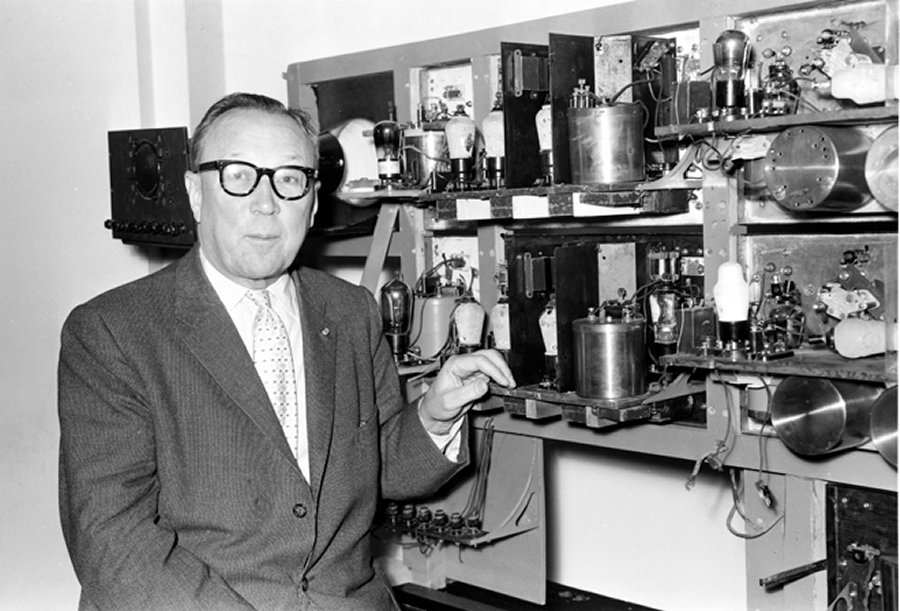
Robert Watson-Watt with his radar 1935
Then came the war, and the importance of radar for countries — and the resources to develop them — increased dramatically. In the US, these resources gathered around a new organization, founded in 1940 at MIT, known as the Rad Lab (it was called so specifically to mislead foreign spies) and create the impression that radioactivity is being investigated in the laboratory - few people then believed in nuclear bombs). The Rad Lab project, which was not as famous as the Manhattan project, still acquired equally outstanding and talented physicists from all over the USA. Five of the first employees of the laboratory (including Luis Alvarez and Isidor Isaac Rabi ) subsequently received the Nobel Prizes. By the end of the war, about 500 doctors of science, scientists and engineers worked in the laboratory, and 4,000 people worked in total. Half a million dollars - which is comparable to the total budget for creating ENIAC - was spent only on the Radiation Laboratory Series edition, twenty-seven volumes, which described all the knowledge gained in the laboratory during the war (while the US government spent on radar technology was not limited to the budget of Rad Lab ; during the war, the government purchased radars worth three billion dollars).
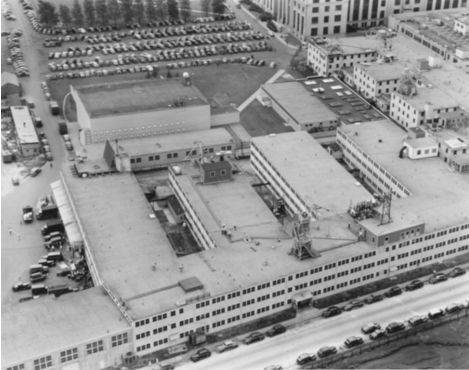
20th MIT building where Rad Lab was located
One of the main areas of research at Rad Lab was high-frequency radar. Early radars used waves with lengths measured in meters. But higher-frequency rays, whose wavelengths were measured in centimeters — microwaves — made it possible to use more compact antennas and less diffuse over long distances, which promised great advantages in range and accuracy of operation. Microwave radar could fit in the nose of the plane and detect objects the size of a periscope submarine.
The first to solve this problem was the team of British physicists from the University of Birmingham. In 1940, they developed a “ resonant magnetron, ” which worked like an electromagnetic “whistle,” turning a random pulse of electricity into a powerful and finely tuned beam of microwaves. This microwave transmitter was a thousand times more powerful than its closest competitor; He opened the way to the creation of practical high-frequency radar transmitters. However, he needed a companion, a receiver capable of detecting high frequencies. And at this point we return to the history of semiconductors.
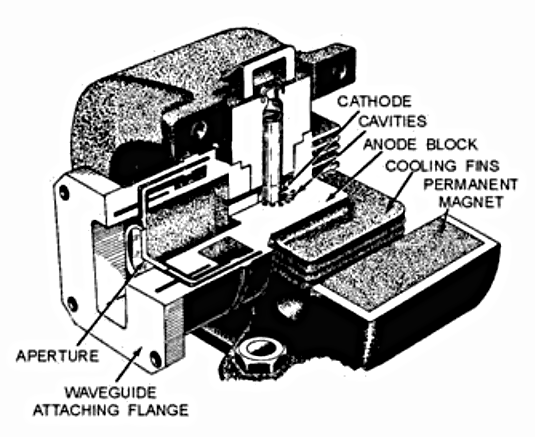
Sectional magnetron
The Second Coming of the Feline Usa
It turned out that the electron tubes were not at all adapted for receiving microwave radar signals. The gap between the hot cathode and the cold anode creates a capacitance, due to which the circuit refuses to operate at high frequencies. The best technology for high-frequency radar available was the old-fashioned " cat's whisker " - a small piece of wire, pressed against a semiconductor chip. Several people discovered this independently of each other, but what happened in New Jersey is closest to our history.
In 1938, Bell's laboratories signed a contract with the navy for the development of a radar fireman in the range of 40 cm — it was much shorter and, therefore, more frequent than the radars that existed at that time before the resonant magnetrons. The main research work was given to the laboratory division in Holmdel, south of Staten Island. It didn’t take long for the researchers to understand what they would need for a high-frequency receiver, and soon engineer George Southworth was combing radio stores in Manhattan in search of old “cat whiskers” detectors. As expected, it worked much better than the detector on the lamps, but did so unstable. Therefore, Southworth sought out an electrochemist named Russell Ol, and asked him to try to improve the homogeneity of the response of the crystal detector with a single point of contact.
Ol was a rather peculiar person, who considered the development of technology to be his destiny, and told about periodic insights with visions of the future. For example, he stated that back in 1939 he knew about the future invention of a silicon amplifier, but that fate was destined to invent it to another person. After examining dozens of options, he settled on silicon, as the best substance for Southworth receivers. The problem was the ability to control the contents of the material in order to control its electrical properties. At that time industrial silicon blanks were widely distributed, they were used in steel mills, but nobody in such a production was concerned, say, the content of 1% phosphorus in silicon. Enlisting the help of a couple of metallurgists, Ol set out to get much cleaner blanks than previously possible.
In the process, they found that some of their crystals straightened current in one direction, while others - in another. They called them "n-type" and "p-type". Further analysis showed that different types of impurities were responsible for these types. Silicon is in the fourth column of the periodic table, that is, it has four electrons on the outer shell. In a pig of pure silicon, each of these electrons would be combined with a neighbor. Impurities from the third column, for example, boron, in which one electron is smaller, created a “hole”, additional space for the movement of current in the crystal. The result was a p-type semiconductor (with an excess of positive charges). Elements from the fifth column, for example, phosphorus, gave additional free electrons for carrying the current, and an n-type semiconductor was obtained.
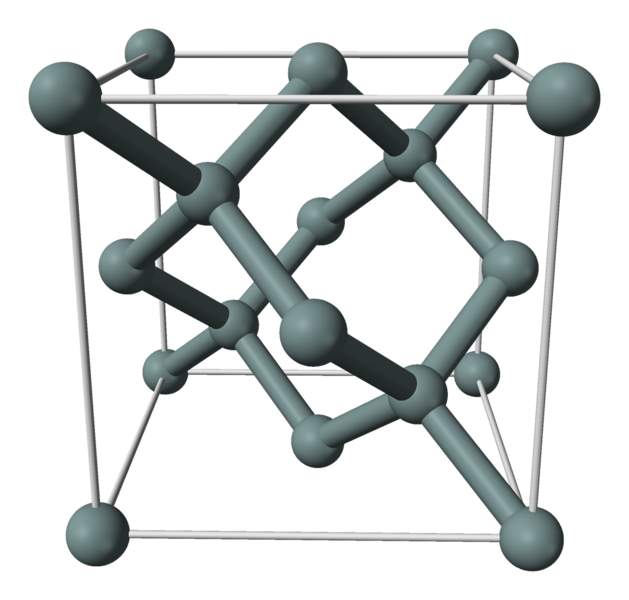
Silicon crystal structure
All these studies were very interesting, but by 1940 Southworth and Olom did not come close to creating a working prototype of a high-frequency radar. At the same time, the British government demanded immediate practical results because of the looming threat from the Luftwaffe, where they already created ready-to-produce microwave detectors working in tandem with magnetron transmitters.
Soon, however, the balance of technological advances will be on the western side of the Atlantic. Churchill decided to reveal all the technical secrets of Britain to the Americans before the war really entered (because, as he supposed, it had to happen anyway). He believed that it was worth risking a leak of information, because then all the industrial capabilities of the United States would be thrown at solving problems such as atomic weapons and radars. The British science and technology mission (better known as the Tizard mission ) arrived in Washington in September 1940 and brought a gift in the form of technical wonders.
The discovery of the incredible power of the resonant magnetron and the effectiveness of British crystal detectors in receiving its signal has revived the research of Americans in the field of semiconductors as the basis of high-frequency radars. Much work had to be done, especially in the field of materials science. To satisfy the demands, semiconductor crystals “required to be produced in millions, much more than was possible before. It was necessary to improve the straightening, reduce the sensitivity to shocks and the probability of burnout, and minimize the difference between the different batches of crystals. "

Point Contact Silicon Rectifier
Rad Lab has opened new research departments to study the properties of semiconductor crystals and how they can be changed to maximize valuable properties as a receiver. The most promising materials were silicon and germanium, so Rad Lab decided to play it safe and launched parallel programs to study both: silicon at the University of Pennsylvania, and germanium at Purdue. Industrial giants such as Bell, Westinghouse, Du Pont, and Sylvania started their own semiconductor research programs, and began developing new production facilities for crystal detectors.
By common efforts, the purity of the crystals of silicon and germanium could be raised from 99% at the beginning to 99.999% - that is, to one particle of impurity per 100,000 atoms. In the process, the staff of scientists and engineers became familiar with the abstract properties of germanium and silicon and applied technologies to control them: melting, growing crystals, adding necessary impurities (such as boron, increasing conductivity).
And then the war ended. The demand for radar has disappeared, but the knowledge and skills acquired during the war have not gone away, and the dream of a solid-state amplifier has not been forgotten. Now the race was to create such an amplifier. And at least three teams were in a good position to get this prize.
West lafayette
The first was a group from Purdue University under the direction of an Austrian physicist named Karl Lark-Horowitz. With the help of talent and influence, he single-handedly pulled the university’s physical department out of oblivion and influenced Rad Lab’s decision to entrust it to a Germanium research laboratory.
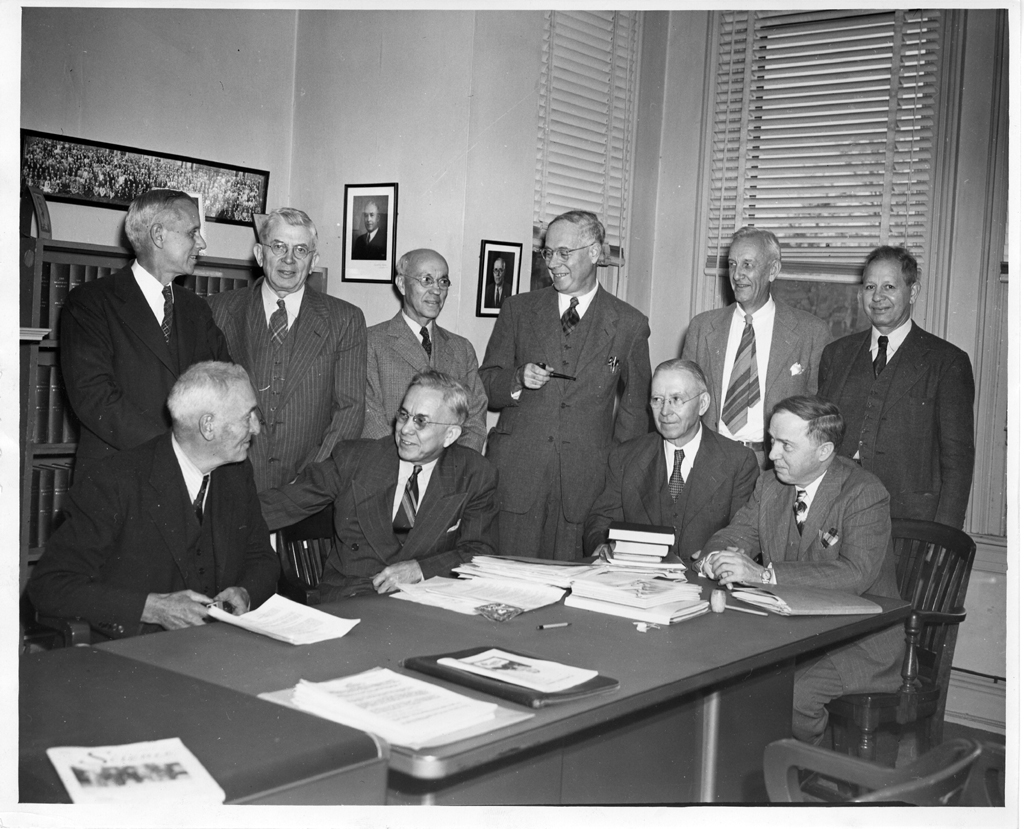
Karl Lark-Horowitz in 1947, in the center, with a pipe
By the early 1940s, silicon was considered the best material for radar rectifiers, but the material located directly below it on the periodic table also looked worthy of further study. Germany had a practical advantage due to the lower melting point that facilitated work with it: about 940 degrees, compared to 1,400 degrees for silicon (almost like steel). Due to the high melting point, it was extremely difficult to make a blank that would not flow into the molten silicon, contaminating it.
Therefore, Lark-Horowitz and his colleagues spent the entire war studying chemical, electrical and physical properties of germanium. The most important obstacle was the “reverse voltage”: the germanium rectifiers stopped the current at a very low voltage and allowed it to flow in the opposite direction. A reverse current pulse burned the rest of the radar components. One of Lark-Horowitz's graduate students, Seymour Benzer, studied this problem for more than a year, and finally developed a tin-based additive that stopped backward pulses at voltages up to hundreds of volts. Shortly thereafter, Western Electric, Bell's laboratories production unit, began producing rectifiers operating according to the Bönzer scheme for military needs.
The study of Germany in Purdue continued after the war. In June 1947, Benzer, while already a professor, reported an unusual anomaly: in some experiments, high-frequency vibrations appeared in germanium crystals. And his colleague Ralph Bray continued to study the "bulk resistance" on the project launched during the war. The bulk resistance described how electricity flows in a germanium crystal at the contact point of the rectifier. Bray discovered that high voltage pulses significantly reduced the resistance of n-type germanium to these flows. Without knowing it, he witnessed the so-called. "Minor" charge carriers. In n-type semiconductors, an excess negative charge serves as the main carrier of charge, but positive “holes” can also carry current, and in this case high-voltage pulses create holes in the germanium structure, due to which minority carriers appear.
Bray and Benzer seductively approached the Germanium amplifier without realizing it. Benzer caught Walter Brattein, a scientist from Bell's laboratories, at a conference in January 1948 to discuss volume resistance with him. He suggested to Brattein to place another point contact next to the first one that could conduct current, and then they could probably understand what was happening under the surface. Bratteyn quietly agreed with this proposal, and left. As we shall see, he knew too well that he could uncover a similar experiment.
One-sous-bois
The Perdue group had both technology and theoretical foundations to make the leap in the direction of the transistor. But they could stumble upon it only by chance. They were interested in the physical properties of the material, and not in the search for a new type of device. A completely different situation prevailed in Onet-sous-Bois (France), where two former radar researchers from Germany, Heinrich Welker and Herbert Matare, led a team whose goal was to create industrial semiconductor devices.
Welker first studied and then taught physics at the University of Munich, managed by the famous theorist Arnold Sommerfeld. Since 1940, he left a purely theoretical path and began working on a radar for the Luftwaffe. Matare (of Belgian origin) grew up in Aachen, where he studied physics. He joined the research department of the German radio giant Telefunken in 1939. During the war, he moved his work from Berlin to the east to the abbey in Silesia to avoid air raids by the Anti-Hitler coalition, and then back to the west to avoid the advancing Red Army, and eventually fell into the hands of the American army.
Like their rivals from the Anti-Hitler coalition, by the early 1940s, the Germans knew that crystal detectors were ideal receivers for radars, and that silicon and germanium were the most promising materials for their creation. During the war, Matar and Welker tried to improve the efficient use of these materials in rectifiers. After the war, both were subjected to periodic interrogations regarding their military work, and eventually received an invitation from a French intelligence officer to Paris in 1946.
Compagnie des Freins & Signaux ("the company of brakes and signals"), the French division of Westinghouse, received a contract from the French telephone management to create solid-state rectifiers and was looking for German scientists to help. Such a union of recent enemies may seem strange, however, this agreement was quite favorable for both parties. The French, who were defeated in 1940, did not have the opportunity to gain knowledge in the field of semiconductors, and they desperately needed the skills of the Germans. The Germans could not lead the development in any high-tech areas in the country occupied and destroyed by the war, therefore they jumped at the possibility of continuing the work.
Welker and Mataret set up a headquarters in a two-story house in the suburbs of Paris, One-sous-Bois, and with the help of a team of technicians they established a successful release of germanium rectifiers by the end of 1947. Then they turned to more serious prizes: Welker returned to the superconductors that interested him, and Mataret amplifiers.
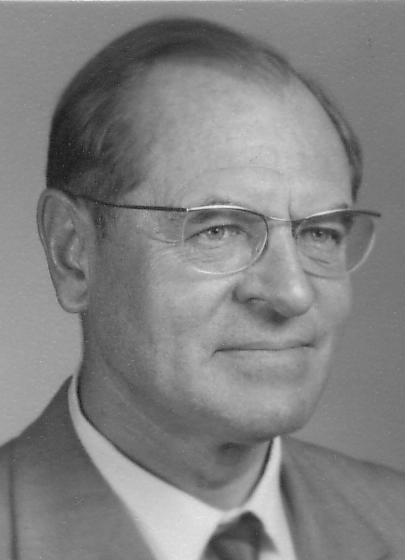
Herbert Matare in 1950
During the war, Matare experimented with rectifiers with two point contacts - “duodiodes” - in an attempt to reduce the noise in the circuit. He resumed his experiments and soon discovered that the second “cat's mustache,” located at 1/100 million of a meter from the first, could sometimes modulate the current through the first mustache. He created a solid-state amplifier, albeit a rather useless one. To achieve more reliable work, he turned to Welker, who had gained extensive experience working with germanium crystals during the war. Velker's team grew larger and cleaner samples of germanium crystals, and together with an improvement in the quality of the material, by June 1948, the amplifiers with the point contact of Mathare became reliable.
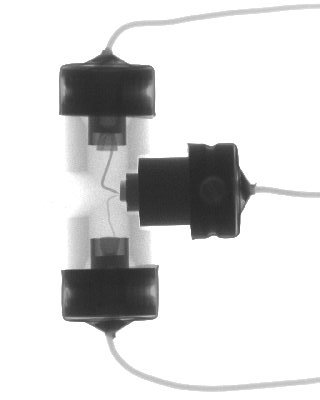
X-ray of a “transistor” based on the Matare scheme, which has two points of contact with germanium
Matare even had a theoretical model of what was happening: he believed that the second contact was making holes in Germany, accelerating the passage of current through the first contact, supplying minority charge carriers. Welker did not agree with him, and believed that what was happening depended on some kind of field effect. However, before they could work out a device or a theory, they learned that a group of Americans had developed exactly the same concept — a germanium amplifier with two point contacts — six months earlier.
Murray Hill
At the end of the war, Mervyn Kelly reformed Bell's semiconductor research group led by Bill Shockley. The project has grown, received more funding, and moved from the original lab building in Manhattan to an expanding campus in Murray Hill (New Jersey).
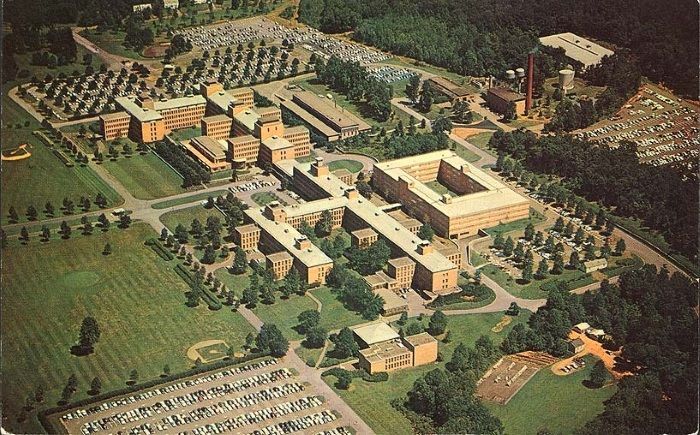
Campus in Murray Hill, approx. 1960
In order to get acquainted with advanced semiconductors again (after he was engaged in operations research in the war), in the spring of 1945 Shockley visited Russell Ola's laboratory in Holmdel. Ol spent the war years working on silicon and wasted no time. He showed Shockley a coarse amplifier of his own building, which he called a “desister”. He took a silicon point contact rectifier and sent current from the battery through it. Apparently, the heat of the battery reduced the resistance through the point of contact, and turned the rectifier into an amplifier capable of transmitting incoming radio signals to a circuit powerful enough to feed the speaker
The effect was rough and unreliable, unsuitable for commercialization. However, it was enough to confirm Shockley's opinion about the possibility of creating a semiconductor amplifier, and that this should be done as a priority direction of research in the field of solid-state electronics. Also, this meeting with the Ola team convinced Shockley that silicon and germanium should be studied first. They showed attractive electrical properties, and in addition, Ola's colleagues, metallurgists Jack Skaff and Henry Terer, achieved tremendous success in growing, cleaning, and adding impurities to these crystals during the war, surpassing all the technologies available to other semiconductor materials. Shockley's group was no longer going to waste time on pre-war copper oxide amplifiers.
With the help of Kelly, Shockley began to assemble a new team. Among the key players was Walter Brettein, who helped Shockley with his first attempt to create a semiconductor amplifier (in 1940) and John Bardeen, a young physicist and a new employee of Bell laboratories. Bardeen probably had the most extensive knowledge of the physics of solids from all the team members - his dissertation described the energy levels of electrons in the structure of metallic sodium. He was also another protege of John Hazbrook Van Vleck, like Atanassov and Bretteyn.
And like Atanasov, Bardin and Shokli’s dissertations required complicated calculations. They had to use the quantum mechanical theory of semiconductors, defined by Alan Wilson, in order to calculate the energy structure of materials using the Monroe desktop calculator. Helping to create a transistor, they, in fact, contributed to the future students' deliverance from such labor.
Shockley’s first approach to a solid-state amplifier relied on what was later called the “ field effect ”. He hung a metal plate above an n-type semiconductor (with an excess of negative charges). The application of a positive charge to the plate pulled out an excess of electrons to the surface of the crystal, creating a river of negative charges, through which electric current could easily flow. The amplified signal (represented by the charge level on the plate) in this way could modulate the main circuit (passing over the semiconductor surface). The efficiency of this scheme was prompted to him by his theoretical knowledge in physics. But, despite the many experiments and experiments, the scheme did not work.
By March 1946, Bardeen created a well-developed theory that explained the reason for this: the surface of a semiconductor at the quantum level behaves differently from its interior. Negative charges pulled to the surface fall into the trap of "surface states" and block the penetration of the electric field from the plate into the material. The rest of the team found this analysis convincing, and launched a new research program in three ways:
- Prove the existence of surface states.
- Examine their properties.
- Figure out how to beat them and make a working field effect transistor .
After one and a half years of research and experimentation, on November 17, 1947, Brettein made a breakthrough. He found that if you place a liquid filled with ions, for example, water, between a plate and a semiconductor, the electric field from the plate will push the ions to the semiconductor, where they will neutralize the charges caught in surface states. Now he could control the electrical behavior of a piece of silicon by changing the charge on the plate. This success gave Bardin an idea for a new approach to creating an amplifier: surround the point of contact of the rectifier with electrolytic water, and then use the second wire in water to control surface states, and thus control the level of conductivity of the main contact. So Bardin and Bretteyn came to the finish line.
Bardeen's idea worked, but the gain was weak and worked at very low frequencies, inaccessible to the human ear - so it was useless as a telephone or radio amplifier. Bardin proposed to switch to Germany, which was resistant to reverse voltage, obtained in Purdue, considering that less charges would collect on its surface. Suddenly they received a powerful boost, but in the opposite direction from the expected. They discovered the effect of minority carriers — instead of the expected electrons, the current through germanium was amplified by holes coming from the electrolyte. The current on the wire in the electrolyte created a p-type layer (an area of excess positive charges) on the surface of n-type germanium.
Subsequent experiments showed that the electrolyte was not needed at all: simply by placing two contact points closely on the surface of germanium, it was possible to modulate the current from one of them to the other. To bring them as close as possible, Bretteyn wrapped a piece of gold foil around a triangular piece of plastic, and then carefully cut the foil at the end. Then, using a spring, he pressed the triangle to Germany, as a result of which the two edges of the incision touched its surface at a distance of 0.05 mm. This gave the prototype transistor from Bell's laboratories its distinctive appearance:
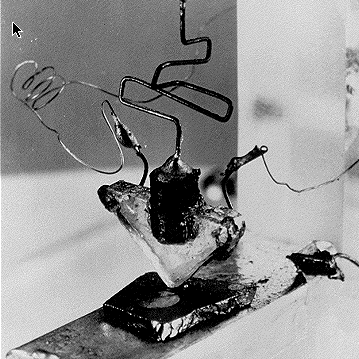
The prototype transistor of Brettein and Bardeen
Like the device of Matare and Velker, it was, in principle, a classic "cat's whisker", just with two points of contact instead of one. December 16, he gave a significant increase in power and voltage, and a frequency of 1000 Hz in the range of audibility. A week later, after minor improvements, Bardeen and Brettein received a voltage increase of 100 times and power 40 times, and showed Bell's directors that their device can reproduce audible speech. John Pierce, another member of the solid-state device development team, coined the term “transistor” based on the name of the Bell rectifier on copper oxide, a varistor.
For the next six months, the lab kept the new creation secret. The management wanted to make sure that they would have a head start in realizing the commercial capabilities of the transistor before someone else got it. The press conference was scheduled for June 30, 1948, just in time to break all the dreams of Welker and Matare of immortality. Meanwhile, the semiconductor research group has quietly collapsed. Hearing the achievements of Bardeen and Brettein, their boss, Bill Shockley, began working to appropriate all the glory for himself. And although he played only an observant role, Shockley received an equal, if not a big advertisement in a public presentation - as can be seen from this published picture, where he is in the thick of things, and right at the laboratory table:
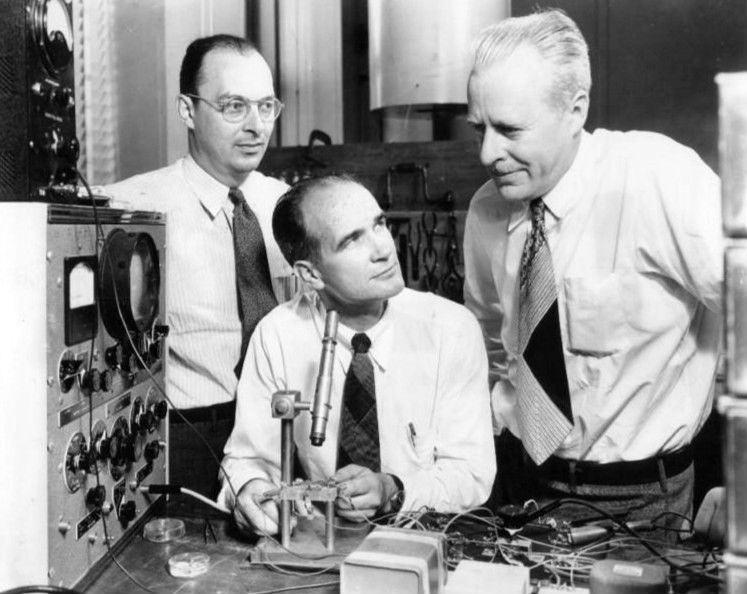
Advertising photo of 1948 - Bardin, Shockley and Brettein
However, Shockley was not enough equal glory. And even before anyone outside Bella's laboratories found out about the transistor, he took up his re-invention in order to appropriate it to himself. And this was only the first of many such repeated inventions.
What else to read
- Robert Buderi, The Invention That Changed the World (1996)
- Michael Riordan, “How Europe Missed the Transistor,” IEEE Spectrum (Nov. 1, 2005)
- Michael Riordan and Lillian Hoddeson, Crystal Fire (1997)
- Armand Van Dormael, “The 'French' Transistor,” www.cdvandt.org/VanDormael.pdf (1994)
Source: https://habr.com/ru/post/448576/
All Articles